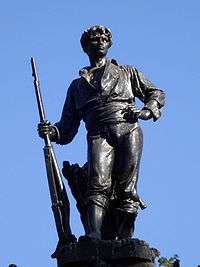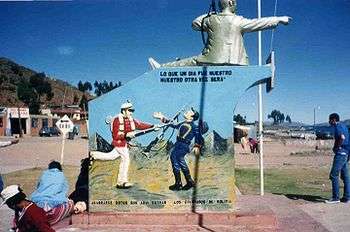Roto
Roto, f. rota, (literally "torn" or "broken") is a term used to refer to Chilean people and in particular to the common Chilean. In Chile from the start of the 20th century it was applied with a negative classist connotation to poor city-dwellers. It is also used contemptuously in other Spanish-speaking countries, especially Bolivia[1] and Peru, to refer to Chileans in a derogatory manner. Otherwise, despite its defects, the roto is also considered a figure of national identity and pride in Chile.


Historical usage
The term roto has been used in Peru since the times of the Spanish conquest, when Diego de Almagro's disappointed troops returned to Cuzco (after a failed gold-seeking expedition in Chile) with their torn clothes, due to the extensive and laborious passage on foot through the Atacama desert.[2][3] In the early days of Santiago its inhabitants were notoriously poorly dressed as result of a lack of food and supplies. Some Spanish came to dress with hides from dogs, cats, sea lions and foxes.[4]
This term became more used after the Chilean campaigns against the Peru-Bolivian Confederation in 1839 —Chilean troops defeated the confederation at the Battle of Yungay on 20 January 1839.[5] In Chile tributes were paid to the victors of Yungay and, in a gesture of recognition, 20 January was declared the Día del Roto Chileno (in Spanish; Day of the Chilean Roto)[6]— and the War of the Pacific (1879–84).
The figure of the Chilean Roto is commemorated by very diverse organisations and actors such as the Chilean Army, ultra-nationalist activists, the Communist Party and local organisations of ordinary citizens. The Army has a particular appreciation to the figure which was regarded as the main hero –a collective and anonymous hero- of some of the most crucial battles in the war against Bolivia and Peru. In this context, the webpage of the Chilean Army states:[7]
The patriotism, bravery and heroism was embodied in the Chilean roto, who represents the ordinary man that left all to fight for its country. This was the one who fought in Yungay and characterised himself by his fierceness and determination.[8][9]
See also
References
- "Los Colorados de Bolivia en la Guerra del Pacífico" (PHP). batallas.org.
- Cañas Palacios, Gastón (20 September 2010). "Roto chileno" (ASP) (in Spanish). diario.elmercurio.com. Retrieved 2 August 2013.
- Larraín Valdés, Gerardo (2001) [1996]. Diego de Almagro (in Spanish). Luxemburgo. ISBN 956-272-488-3.
[...] los [españoles que volvieron] de Chile estaban en tan pobres condiciones, ya que nadie les daba trabajo ni posibilidades de desenvolverse en alguna actividad, que por sus ropas harapientas los llamaban los rotos chilenos.
- León, Leonardo (1991). La merma de la sociadad indígena en Chile central y la última guerra de los promaucaes (PDF) (in Spanish). Institute of Amerindian Studies, University of St. Andrews. pp. 13–16. ISBN 1873617003.
- López Ardiles, Marcos (17 January 2012). "Batalla de Yungay y conmemoración del roto chileno – Yungay y el roto chileno: El proceso de consolidación de la nacionalidad" (in Spanish). academiahistoriamilitar.cl. Retrieved 15 October 2012.
- Farah, Miguel (14 March 2013). "Días nacionales en Chile: Otros días en que se observan celebraciones" (in Spanish). feriadoschilenos.cl. Retrieved 17 March 2013.
- http://www.ejercito.cl/historia/hisp-ind.htm Archived 5 October 2007 at the Wayback Machine; 15 December 2004
- Epopeya del “roto” chileno, by Oreste Plath.
- Exaltación del mestizo: la invención del roto chileno, by Horacio Gutiérrez.